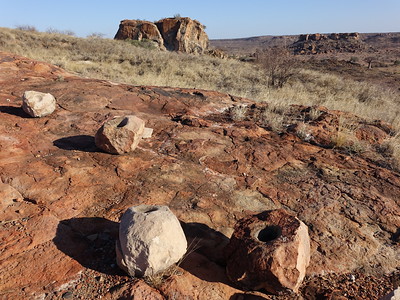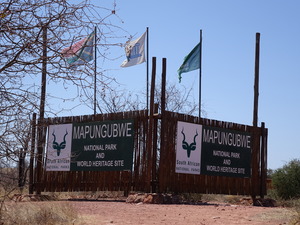Mapungubwe

Mapungubwe Cultural Landscape covers the remains of what once was the most important inland settlement in Southern Africa.
It was the main settlement of the Kingdom of Mapungubwe, in its heydays the largest kingdom in Africa. Its inhabitants traded ivory and gold with the Swahili towns at the Indian Ocean shore from between ca. 900-1300 AD. A sacred royal leadership evolved, in which the royals came to distinguish themselves from the commoners by living in a secluded palace on Mapungubwe Hill. Mapungubwe was abandoned in the 13th century, after a sudden change in climate and/or losing its role on the trade routes.
Community Perspective: the sacred Mapungubwe Hill is only accessible on a guided tour, provided by the park office of the larger national park that it is part of. It’s worth staying a day (or two) longer to enjoy the very scenic surroundings.

Map of Mapungubwe
Community Reviews
Bernard Joseph Esposo Guerrero

Mpungubwe is located far away along the border of South Africa with Botswana and Zimbabwe, and at one of the viewpoints you can see the convergence of the three countries. Prior to the visit, we made it a point to visit the Dzata ruins in the Southspanberg (a World Biosphere Reserve) to serve as a reference and comparison site. Its connections with Mpungubwe and Great Zimbab are quite strong and evident, and it enriches the understanding of the culture from that corner of the globe. In terms of chronology, Mpungubwe preceded Great Zimbab and Dzata came in later using stones from Zimbabwe.
We camped in Mpungubwe for two days and one night where we did a self-drive game viewing, an organized sunset safari (of which we were the only ones who availed), and a morning hike up Mpungubwe Hill. Wildlife in the park is satisfactory for me and since it is not popular for it, chances of encountering other sightseers are slimmer than other game reserves and national parks I have been to before; naturally most would opt to go to nearby Kruger. As we were driving back to Loekwe Camp on our rental car after the sunset drive, we encountered a leopard walking towards us along the dirt road not far from where we stayed. Sightings like that close to the camp had to be reported. The cabin is equipped with a stove, microwave, toaster, and a fridge, and it makes sense to take food along as the only restaurant in the park near the entrance has limited offerings. What makes the landscape different as well is the presence of baobabs, and it may even be a better place to appreciate them than in Musina Boabab Nature Reserve.
The guide to the hill carried a gun and he first led us to a dig site that is kept close unless there are visitors. The hike up the hill is easy, yet steep. The promontory affords an unobstructed view of the former kingdom, so it comes as no surprise that the site was chosen as it is quite central and the landscape made it easy to defend. On top, there are structural ruins and rock-carved holes marking the corners of houses or palaces. There is also a royal graveyard of which the excavated remains were again interred following a formal ceremony, as well as a reservoir and a game corner (of which the guide demonstrated how those games worked). The site of habitation was move three times, and they are named as A (K2) , B (Schroda), and C (the hill). The remains of the two others, however, are scant. An interesting landform is the Rainmaker, considered sacred by the locals to this day. The national park covers a larger area than the inscribed relict cultural landscape.
The museum prides itself as a modern architectural gem and has even reaped awards. It houses replicas of the most important finds such as the golden rhinoceros and the scepter, as well as what I can only surmise as original stoneware and beads. Interestingly, it appears that who Svein referred to as the uncle of their guide happened to have been the guide we got, and so I did not pass on buying a copy of his book, which largely tackles their traditions and beliefs, after the tour. Visiting Mpungubwe early this year concluded the chase for current World Heritage Sites of South Africa, and it can surprisingly be quite a magical place.
Svein Elias

Mapungubwe National Park is located 5-6 hours of driving north of Jo’burg airport or 2 ½ hours north of Polokwane. Inside the national parks resides the world heritage site of Mapungubwe Cultural Landscape. The heritage site is just a small part of the park although the national park is not very big either.
The tracks leading to heritage site is open only to those who join the Heritage Tour which is at 7 in the morning and at 10. The park has a circular dirt ring road and the hill that is the centre of the heritage site can easily be seen from the road, but you must know what you are looking for (the correct one between several hills).
On the heritage tour a guide takes you in a park safari vehicle straight to the hill. When leaving the vehicle, he loads his gun and the takes you by foot to the foot of the hill and up. The entrance is by a wooden stairway which is placed in the same narrow gap as the ancient sacred passage is. On top there are numerous small remains and marks showing what once used to be the royal area of this kingdom. The guide is good and very intense. He knows his story and probably is somehow related to it. After a question from one of the two other people on the tour I understood that the guide’s his uncle has written a book about the site. The story and the site itself are interesting although remains of the kingdom are not very visible.
Later we visited the little museum close to the park entrance. A small but only slightly interesting museum. You can’t help feeling that there are parts missing, parts that’s taken care of by the museums elsewhere.
We stayed in the Leokwe Camp for two nights. The camp is a self-service camp which means you bring your own food. It is a really good way to spend some time in this park. We spent every moment during daylight roaming the park. The dirt ring road I guess are possible to go by a saloon/domestic vehicle, but the fun part really lies in using the more extended roads, the 4x4 tracks. There are easy ones and toucher ones, and by far – the small tough extensions to the ring road are the more rememberable.
The landscape inside the park is remarkable different to the more flattened and boring landscape we passed through on the way up here. It’s rough, rugged, and rocky. It’s up and down, small gorges and hills. Very scenic! Quite a few animals are around but mostly the “regular ones” (like gazelles, zebras, and elephants). There are baobab trees which can make a fantastic scenery for photographing the sunsets and sunrises.
We found a treetop walk that makes you walk up “through the trees”, but nature has taken its revenge. The walk was supposed to continue onto the Limpopo River, but that part was smashed during some rainy season. We could see some remains into the water. Maybe they’ll rebuild it someday.
Also, The Confluence Point, which is a panoramic viewpoint overlooking the junction between the Limpopo and Shashe River, is a nice area.
Since the heritage site is in such a wonderful national park spending some tome there is recommended. At least if you’ve taken the step of bringing a specialized vehicle (4x4).
Els Slots

Mapungubwe Cultural Landscape lies at the northern border of South Africa, adjoining Botswana and Zimbabwe. This remote setting probably accounts for its low profile and limited visitor numbers, even among World Heritage Travellers (ranking 830th out of 1052). In the nomination file it was noted that although many WHS have to deal with high numbers of visitors, the sustainability of Mapungubwe is threatened by attracting too few of them.
What I found however was a well-cared-for National Park, worth anyone’s visit for a day or so. On my first two half-day trips into the park, I focused on game drives and brushed up my mammal list total: I saw mongoose, klipspringer, southern giraffe and steenbok for the first time. The park isn’t teeming with wildlife: there are no fences between the park and the adjoining zones in Botswana and Zimbabwe, so the animals migrate a lot between the three countries. Also, the density of mopane bushes makes it hard to see smaller animals. But especially the dramatic landscape, with lots of old baobab trees, ridges and canyons make the park attractive.
Mapungubwe was a large inland settlement that pre-dates the much better-known Great Zimbabwe. There’s a hint of Kernave to its story: the chief with his close allies lived in a palace on the hill, while the common people inhabited villages below. In its heyday in the 13th century, the society is believed to have consisted of 9,000 people. While large parts of the park can be explored with your own car, that hill (Mapungubwe Hill) is only accessible with a guided tour from the park office. These 'Heritage Tours' are conducted 3 times a day, and I booked a spot on the 4 p.m. tour about two hours before. I was the only participant.
The flat-topped hill where the archaeological findings have been made lies in a startling green part of the park. Vegetation shows that a river flowed here in the past, so the Mapungubwe people had chosen their spot well. After a short drive, we left the jeep behind and continued on foot. The guide was carrying a gun: this is lion and elephant territory.
Mapungubwe Hill is where the royal family withdrew at a given time, and where three graves with precious objects have been uncovered. It is a natural fortress, the walls are so steep that no one could approach unseen. From photos that I had seen beforehand, I thought it would be a single outstanding inselberg – but in fact whole Mapungubwe National Park is full of this kind of eroded hills. At neither of the two game drives, I recognized Mapungubwe Hill.
In the past, there was only one way up, via a ladder. We used the same approach. It took some 10 minutes to climb steep stairs (modern wooden ones, fortunately), and then we were on the summit. Although naturally flat, it was made more inhabitable by the former residents by adding sand to it. They (the women apparently) took it from the valley below. The top still is covered with a layer of sand with grass, convenient enough to build your hut. The only visible remains are circular cutouts in the soft red sandstone. There is also a water tank and a granary. Water and grains were obviously provided to the royals by the ordinary people 'from below'.
In 2011 a museum opened at the park to show the Mapungubwe findings. But they have not been very successful since to lure away artifacts from the University of Pretoria Museum where most are stored. Mainly glass beads and ceramics, evidence of the position of the Mapungubwe Kingdom at the Indian Ocean trade route, are shown. The most spectacular of the discoveries is a little gold rhinoceros, made of gold foil and tacked with minute pins around a wooden core. I already had made plans to go and see it in Pretoria on my way up north, but it turns out that the Golden Rhino just moved to the British Museum on a temporary loan! It’s the first time that this symbol of post-Apartheid South Africa has left the country. There’s a copy on show in the Mapungubwe museum.
Read more from Els Slots here.
DAVID
Though it is the nearest heritage site for me to visit, i find it more unbelievable that i am situated next to that place. Mapungubwe is an exciting place to visit because of its climate conditions, the natural well being, and environmental factors such as low pollution, absence of gaseous substances which affetcs the atmospheres. these factor makes the place a healthy site to visit, and even stay. the world did not make a mistake by honouring the place the world heritage site. its just 90 kilo away from me...as i am situated at musina.
Elke
Mapungubwe is a special and sacred place, I have had the honor to go on top of the mountain several times and each time you discover something new about the amazing history, myths, legends and culture that lay hidden in the mountain.
It is great climbing up the mountain through the entrance that was once a long time ago a secret entrance hidden by a wild fig tree, its the only way to get on top of the mountain. There is a rope now but long ago there was none and the people who lived there were really clever and made a ladder by grinding holes into the rocks on opposite sides and putting sticks on each side. It great climbing up there (just wear the appropriate clothing}.
Community Rating
Site Info
- Full Name
- Mapungubwe Cultural Landscape
- Unesco ID
- 1099
- Country
- South Africa
- Inscribed
- 2003
- Type
- Cultural
- Criteria
-
2 3 4 5
- Categories
- Cultural Landscape - Relict
- Link
- By ID
Site History
2003 Advisory Body overruled
ICOMOS advised Deferral, due to formal designation of the Vhembe-Dongola National Park & updated mgt plan
2003 Inscribed
Site Links
Unesco Website
Official Website
In the News
Locations
The site has 1 locations
Mapungubwe National Park is only accessible by car. It lies some 50km north of the last town in the very north of South Africa, Alldays. The road is paved (including potholes).
Connections
The site has 19 connections
Art and Architecture
Constructions
Ecology
Geography
History
Timeline
Visiting conditions
WHS on Other Lists
World Heritage Process
Visitors
30 Community Members have visited.
